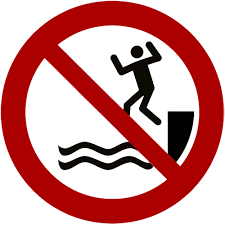Safety on Water
Know how to stay safe in the water.
When swimming or using watercraft, you should always take safety precautions, use the correct equipment, and obey the law.
Contents:
Swimming
Swimming in the sea is more hazardous than swimming at the local pool. Read this information to be aware of the dangers and swim safely.
Swim Safely
The safest swimming location on Folkestone’s coast is at Sunny Sands beach, especially when lifeguards are on duty. Another safer area to swim is in the shelter of the breakwater rocks at Mermaid Beach, but this beach has no lifeguards.
You should only swim during daylight hours, and avoid swimming alone. Consider joining an experienced local sea swimming group, such as Kent Sea Swimmers.
Swim between the red & yellow flags at Sunny Sands.
- When the red and yellow flags are flying, lifeguards are on duty in this area.
- Outside of the red and yellow flags, there are many more hazards and hidden dangers.
- Check the information boards at Folkestone Rescue’s lifeguard station to make sure you are aware of tide times, weather, and any dangers.
- If you are not a strong swimmer, or have never swum before, consider practising at your local swimming pool before trying to swim in the sea.
- Swimming is not permitted in Folkestone Harbour due to the many dangers in that area.
Always stay close to shore when swimming.
- If you swim away from shore and get into difficulty, you may not be able to swim back.
- The further away from shore you are, the longer it will take for rescuers to reach you.
Do not swim while under the influence of alcohol or drugs.
- Alcohol and drugs will impair your judgement and swimming ability.
- People under the influence of alcohol or drugs are far more likely to get into difficulty and drown while swimming.
Rip Currents & Rip Tides
Rip currents and rip tides are strong fast-flowing currents of water in the sea. It is possible to become caught in a rip current when swimming in the sea.
A rip current will pull you away from shore quickly.
- Rip currents can flow very fast and can be too strong for anyone to swim against.
- Rip currents can occur without warning.
If you are caught in a rip current:
- Do not swim against the rip towards the shore; you will quickly become exhausted.
- Swim parallel to (along) the shoreline until you are free of the current.
- Once you have left the current, you will then be able to swim towards shore.
Inflatables
Small inflatables, such as airbeds, rings, and other novelty shapes, should only be used in swimming pools.
Do not use inflatables at the beach.
- If you use an inflatable at the beach, you are at risk of being taken out to sea by the wind or tide.
- Even a gentle breeze can quickly move inflatables away from the beach.
- Children using inflatables in the water are especially at risk from this.
Watercraft
There are many different types of watercraft, including kayaks, paddle boards, personal watercraft, dinghies, and powerboats.
Using Watercraft
When using any type of watercraft, there are some general safety precautions you should take, and regulations you may have to follow.
Before taking any craft on to water, register with SafeTrx.
Available on Apple, Android & website, the SafeTrx system:
- Alerts the Coastguard if you fail to return to shore.
- Immediately connects you with the Coastguard in an emergency.
- Enables the Coastguard to locate you quickly.
Always wear a life jacket or buoyancy aid when using watercraft.
- Every person on a craft should wear a life jacket or buoyancy aid, correctly fastened before the craft sets off.
- These will help to keep you afloat in the event of an accident.
- If you are not already wearing a life jacket or buoyancy aid when on the water, you may not have time to put one on when it is needed.
It is against the law to break International Safety Regulations when taking a boat to sea.
- You could be prosecuted if you’re involved in a boating accident and you haven’t followed the regulations.
- You can read more about the law and how it applies to boat owners at https://www.gov.uk/owning-a-boat.
Motorised Watercraft
Motorised pleasure craft, such as power boats or personal watercraft (also known as “Jet Skis”), can be good fun to use. For more information on using personal watercraft in Kent, download the Kent Coastal Network’s guide:
There are some specific laws and safety restrictions that apply when using motorised watercraft at Folkestone:
It is against the law to drive a motorised watercraft dangerously or inconsiderately.
- Driving a motorised watercraft dangerously or inconsiderately could put lives at risk.
- You could be prosecuted and fined up to £1,000 for doing this.
It is against the law to exceed 8 knots in the speed restriction zones.
- Speed restriction zones stretch along Folkestone’s coast from Sunny Sands to Mermaid Beach.
- The zones extend 200 meters from the shore out to sea, and around Folkestone Harbour Arm.
- The speed restriction applies from 1st May to 30th September.
- You could be prosecuted and fined up to £1,000 for exceeding the speed limit.
Keep motorised watercraft at least 200 meters away from Sunny Sands beach at all times.
- It is dangerous to bring a motorised craft close to swimmers.
- You could be prosecuted and fined up to £1,000 for doing this.
- Personal watercraft should not be launched from Sunny Sands beach.
Always use a kill cord when driving a motorised watercraft.
- A kill cord will stop your craft’s engine if you fall off or are knocked off.
- Failing to wear a kill cord could put lives at risk.
Personal watercraft are not permitted in Folkestone Harbour.
- You should not bring personal watercraft into the harbour.
Water Wildlife
The waters around Folkestone contain many different creatures. Some are hazardous, while others are protected by law.
Jellyfish
There are many jellyfish around Folkestone’s coast. Some types can inflict a painful sting, usually leaving a red mark on the skin.

Wearing a wetsuit or rash vest will help protect you from being stung.
Never touch or handle marine creatures.
If you have been stung by a jellyfish:
- Leave the water and keep still.
- Remove any remaining tentacles with tweezers whilst wearing gloves.
- Rinse the affected area with sea water.
- Do not apply any other liquids or substances to the affected area; these may make the injury worse.
- Taking painkillers such as paracetamol and ibuprofen will help to lessen any pain or swelling.
- If you have difficulty breathing after being stung, you should seek medical attention immediately by calling 999.
Weever Fish
Weevers are small brown fish common around Folkestone’s coast. The Weever fish buries itself in the sand, and has venomous spines which can inflict a very painful sting. The pain will initially feel like a scratch, but will gradually increase over several minutes. The sting may also cause swelling, nausea, headaches, or dizziness.

Always wear footwear such as pool shoes, sandals, or wetsuit boots to protect your feet when entering the water.
Never touch or handle marine creatures.
If you have been stung by a Weever fish:
- You should seek medical attention by calling NHS 111.
- Submerging the affected area in hot water for 30 to 90 minutes will help to control and reduce the pain, but be careful not to burn yourself.
- Taking painkillers such as paracetamol and ibuprofen will help to lessen any pain or swelling.
- If you have difficulty breathing after being stung, you should seek medical attention immediately by calling 999.
The Sea Scorpion is a small brown fish often found in rock pools after the tide has gone out. It also has spines which can puncture skin if handled, but are not venomous.
Dolphins and Seals
You may sometimes see dolphins and seals close to Folkestone’s coast. Occasionally, you may also see seals resting on local beaches.
Dolphins and seals are protected by law under the Wildlife and Countryside Act.
- We recommend you do not approach these animals if you see them while you are swimming.


